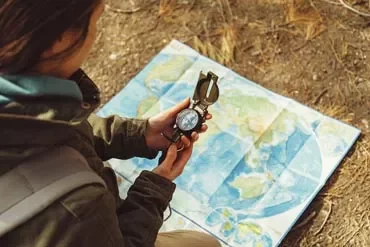You should never hit the hiking trail without two items: a hiking compass and a map. Though many trails are well marked and well-trodden, there are times where you might hit a confusing crossroads or mistake a false shortcut for the trail. In these moments, a compass could save the day…if you know how to use one.
This article covers four important topics:
- The parts of the compass
- How to adjust your compass to the area in which you’ll be hiking
- How to orient your map to identify landmarks and your destination
- How to read your bearings to locate your destination or current location on a map

Anatomy of a Hiking Compass
Part of what makes a compass so intimidating to beginners is its many parts, but each part serves an integral purpose. The following are the essential items you must know in order to use and to read a hiking compass.
Base Plate: The clear plastic base your hiking compass, or needle housing, is attached to.
Magnetized Needle: Usually red or white, the magnetized needle is the free-floating arrow that always points to the magnetic north pole.
Direction-of-Travel Arrow: The arrow on the base plate (outside the needle housing) that signifies which direction to point your compass when taking a bearing.
Rotating Bezel: Graded in degrees, the rotating bezel is a moveable piece that surrounds the hiking compass and is used to take a bearing.
Index Line: The marking located directly above the rotating bezel that’s used when reading a bearing.
Orienting Arrow: The outline of an arrow located inside the hiking compass that’s used to orient the rotating bezel when orienting your map or taking a bearing.
Orienting Lines: The parallel lines that rotate in step with the rotating bezel that are used to align your hiking compass with the north–south grid lines of your map.
How to Use a Hiking Compass
Step 1: Adjust for Declination
Declination is the difference between magnetic north (the direction your magnetized needle points) and true north (the top of your map), and it can mean the difference between arriving at your destination and arriving miles away from it.
The declination value changes depending on your location, as a result of Earth’s magnetic fields and core elements, but it also changes over time. Most topographic maps include the declination value in the map legend, which makes life easy for you.
Backroads Pro Tip
If your map is out of date, you should consult the National Oceanographic and Atmospheric Administration (NOAA) website before your hike. This will give you the most accurate declination data.
You’ll need this declination value in order to set your compass. Most hiking compasses come with instructions about how to do this, but if you happen to have a compass that doesn’t allow for declination adjustments, simply remember to make the adjustment by adding or subtracting the declination value each time you work with a bearing.
Step 2: Orient Your Map
With your compass now adjusted for declination, you can orient your map. Here’s how:
- Begin by placing your compass on top of your map. The direction-of-travel arrow should be pointing toward the top of the map.
- Rotate the rotating bezel until north (N) is lined up with the direction-of-travel arrow.
- Position the base plate of your compass so it’s lined up with either the right or left edge of the map. (Just remember to keep the direction-of-travel arrow pointing toward the top of the map.)
- With your hiking compass positioned correctly on your map, physically rotate your body with the map and compass in hand until the magnetized needle is within the outline of the orienting arrow.
- Your map’s now oriented and can be used, in combination with your compass, to locate direction, destination and landmarks during your hike.
Step 3: Take Your Bearings on a Map or in the Field
A bearing is a more specific way to describe direction of travel from your current location, and it’s the main reason for toting along a compass to begin with. You can use bearings to determine the direction of your destination or to find your location on a map. Here’s how to do both:
How to find your location on a map to determine your destination’s direction in the field:
- With the destination-of-travel arrow pointing in the direction of your destination, put your compass on the map so its straight edge is aligned with both your current location and the destination you are trying to reach.
- Rotate the rotating bezel until the orienting lines are lined up with the north–south grid lines of your map.
- Read the bearing by looking at where the index line falls on the rotating bezel.
- Remove your compass from the map, and hold it so the direction-of-travel arrow is pointing away from you.
- Rotate your body until the magnetized needle is inside the orienting arrow.
- The direction-of-travel arrow is now pointing in the direction of your destination.
How to find your location in the field in order to know your location on a map:
- Begin by finding a landmark you can easily locate on your map.
- Grab your hiking compass, and hold it so the direction-of-travel arrow is pointing away from you and toward your chosen landmark.
- Rotate the rotating bezel until the magnetized needle is inside the orienting arrow.
- Read the bearing by looking at where the index line falls on the rotating bezel.
- Lay your hiking compass on the map with its corner next to the direction-of-travel arrow positioned on your chosen landmark.
- Rotate the entire base plate until the orienting lines are lined up with the north–south grid lines of your map and the north (N) marker of your rotating bezel is pointing in the direction of true north.
- If you draw a line along the straight edge of your hiking compass as it is currently positioned on the map, your location on the map is where that line intersects your trail.
Top Tips for Beginners
Here are a few other key takeaways you should try to keep in mind:
- Always be sure your direction-of-travel arrow is pointing in the direction you want to go.
- Always be sure your orienting arrow is pointing in the direction of the top of your map, or true north.
- Always follow the direction-of-travel arrow after you’ve found your bearings, not the magnetized needle—unless you wish to head true north.
- Always pick a stationary landmark when taking your bearings.
Backroads Pro Tip
If you’re still a bit confused about how to use a hiking compass, the best thing you can do is to take these instructions and to put them into practice in a familiar, low-risk setting.




